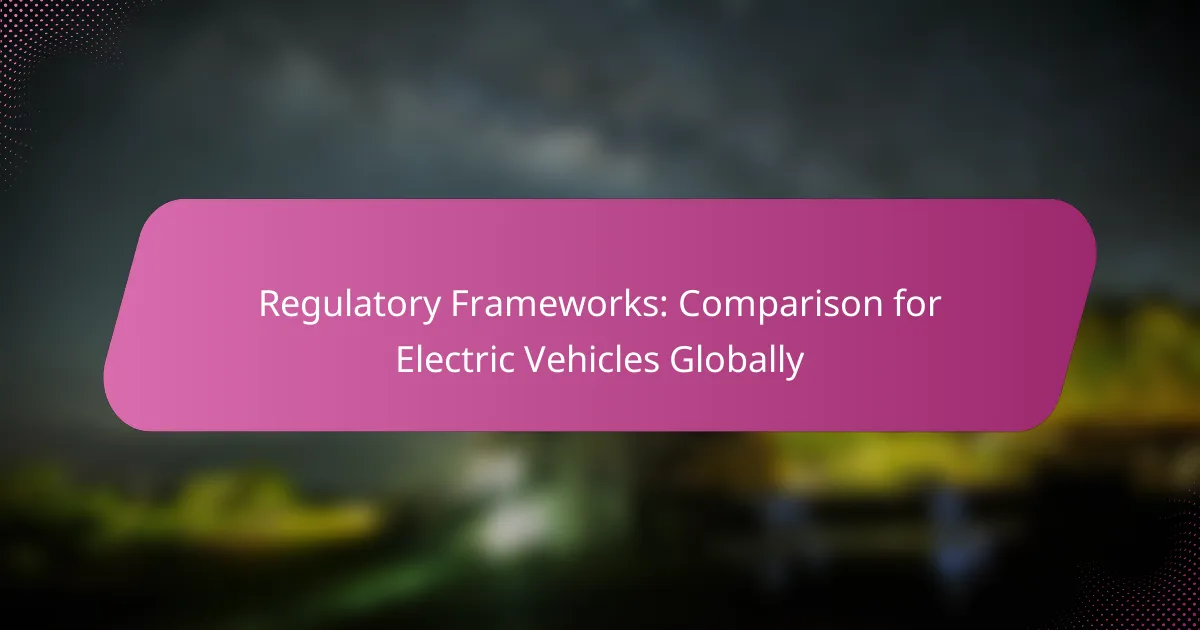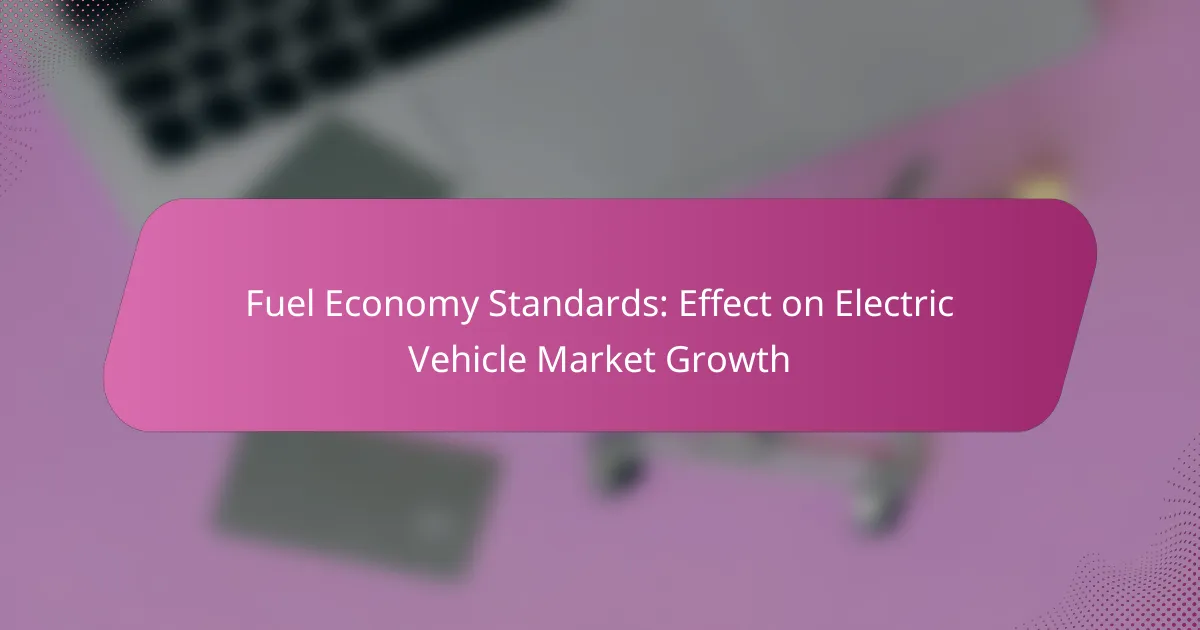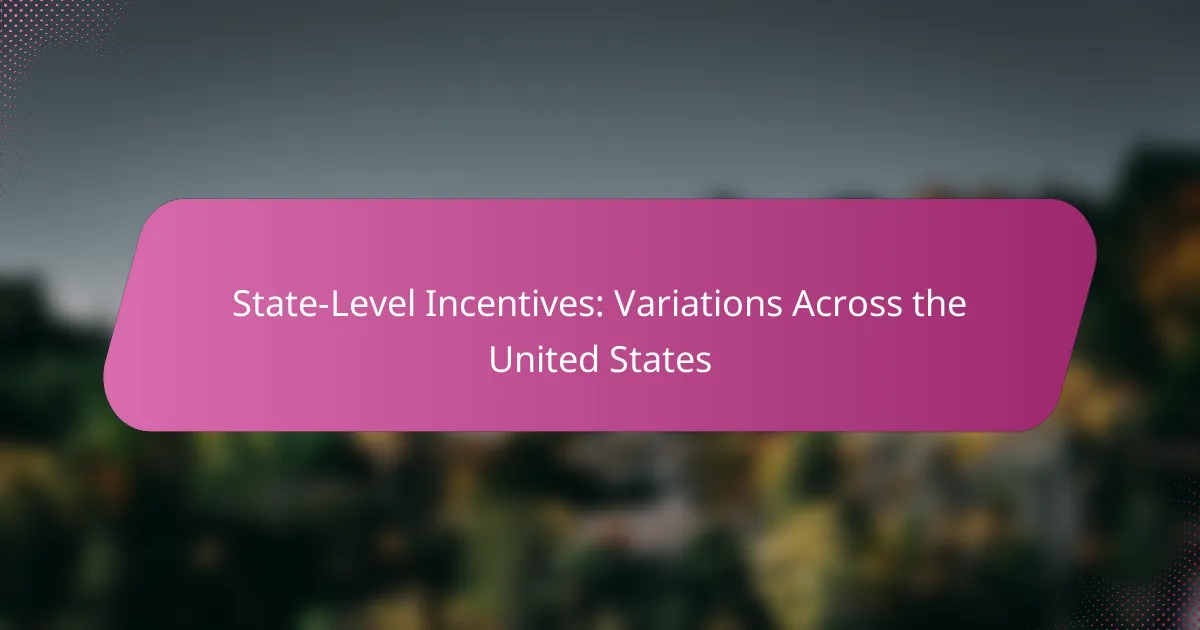Government subsidies play a crucial role in boosting electric vehicle (EV) sales by making them more financially accessible to consumers. Through mechanisms such as federal tax credits, state incentives, and local rebates, these financial aids lower the overall cost of EVs, encouraging more individuals to consider making the switch to electric. States like California, New York, and Texas lead the way in offering substantial subsidies, further enhancing the appeal of EV ownership.
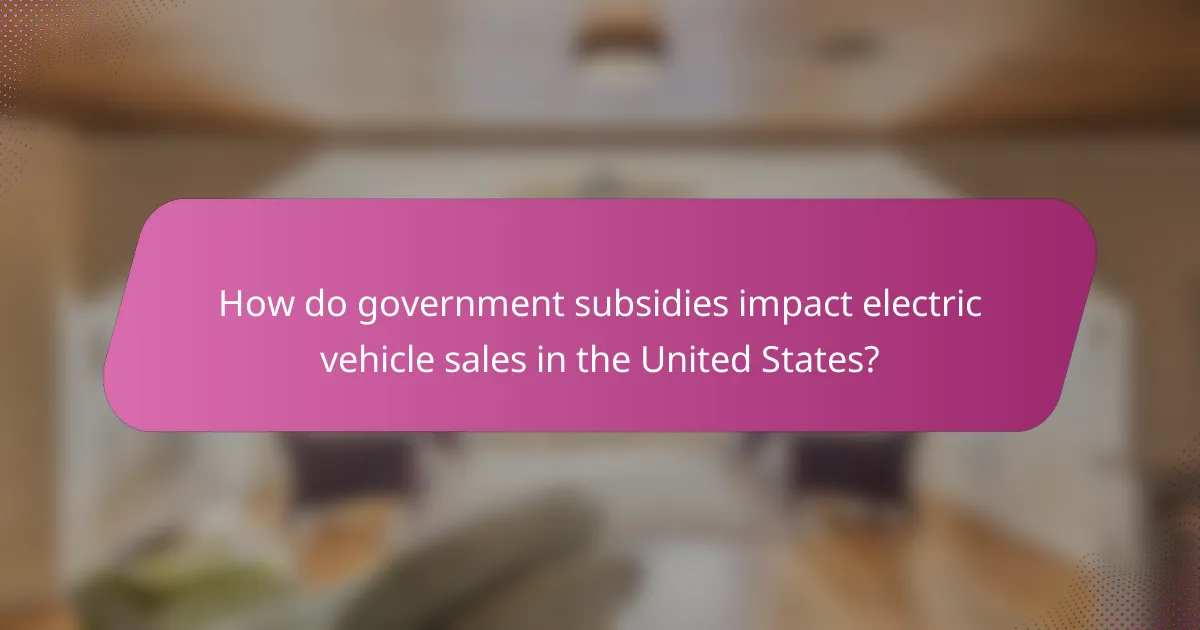
How do government subsidies impact electric vehicle sales in the United States?
Government subsidies significantly influence electric vehicle (EV) sales in the United States by making them more affordable and appealing to consumers. These financial incentives help lower the overall cost of EVs, thereby encouraging more individuals to consider purchasing them.
Increased affordability for consumers
Subsidies, such as tax credits and rebates, reduce the purchase price of electric vehicles, making them more financially accessible. For instance, federal tax credits can range from $2,500 to $7,500 depending on the vehicle’s battery capacity, effectively lowering the upfront cost for buyers.
Additionally, some states offer their own incentives, which can further decrease the total price. This combination of federal and state support can make EVs competitive with traditional gasoline vehicles, especially as fuel prices fluctuate.
Boosted demand for electric vehicles
With increased affordability due to subsidies, demand for electric vehicles has risen significantly. As more consumers find EVs within their budget, sales figures have shown substantial growth, contributing to a broader acceptance of electric vehicles in the market.
Moreover, as awareness of environmental issues grows, many consumers are more inclined to purchase EVs, especially when financial incentives are available. This trend is evident in states with robust subsidy programs, where EV sales often outpace those in areas with limited or no incentives.
Enhanced market competition
Government subsidies not only boost individual sales but also foster competition among automakers. As demand for electric vehicles increases, manufacturers are incentivized to innovate and expand their EV offerings to capture a larger market share.
This competition can lead to improved technology, better vehicle performance, and lower prices over time. As more companies enter the EV market, consumers benefit from a wider selection of models and features, further driving the adoption of electric vehicles.
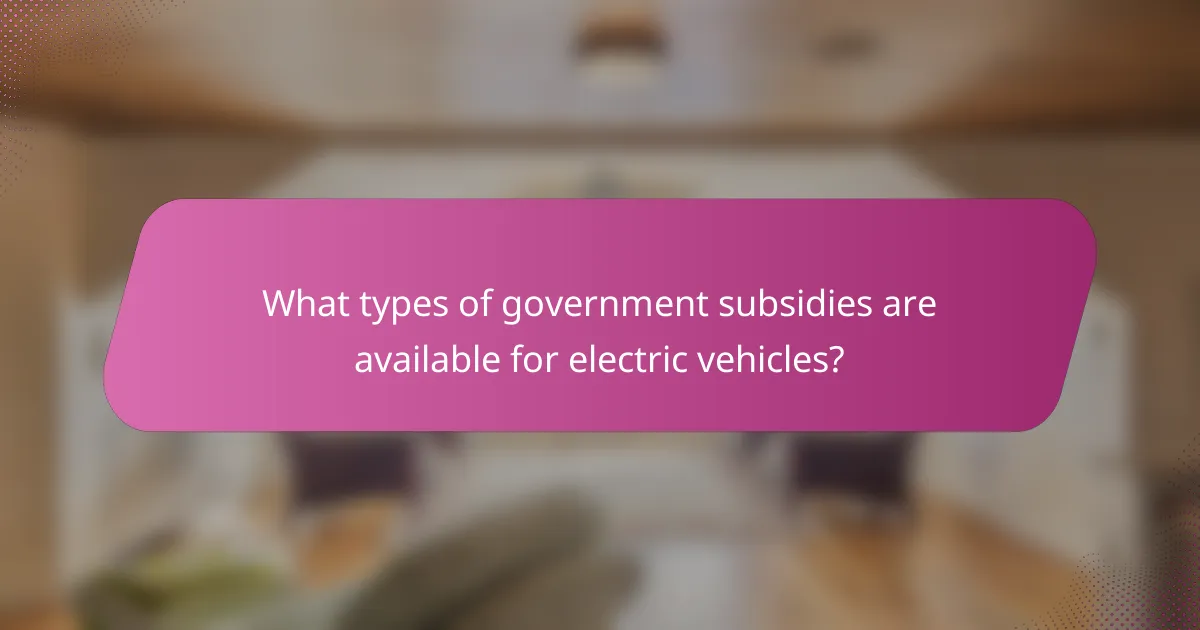
What types of government subsidies are available for electric vehicles?
Government subsidies for electric vehicles (EVs) typically include federal tax credits, state incentives, and local rebates. These financial aids aim to reduce the overall cost of purchasing an EV, making them more accessible to consumers.
Federal tax credits
Federal tax credits are a significant form of subsidy for electric vehicle buyers in the United States. Eligible buyers can receive a credit of up to $7,500 on their federal income tax, depending on the vehicle’s battery capacity and the manufacturer’s sales volume.
To qualify, the vehicle must meet specific criteria, such as being new and having a battery capacity of at least 5 kilowatt-hours. It’s essential to check the current eligibility status, as some manufacturers may reach a sales cap that reduces or eliminates the credit.
State incentives
Many states offer additional incentives for electric vehicle purchases, which can vary widely. These incentives may include tax credits, grants, or rebates that can range from a few hundred to several thousand dollars, depending on the state.
For instance, California provides a rebate program that can offer up to $2,000 for eligible EVs, while other states may have different structures or amounts. Researching your state’s specific offerings is crucial to maximize potential savings.
Local rebates
Local governments and municipalities often provide rebates or incentives for electric vehicle purchases as part of their sustainability initiatives. These local rebates can complement state and federal incentives, further lowering the cost of an EV.
Examples include city-specific programs that offer cash rebates or discounts on registration fees. It’s advisable to check with local government websites or agencies to find out what is available in your area, as these programs can change frequently and may have limited funding.
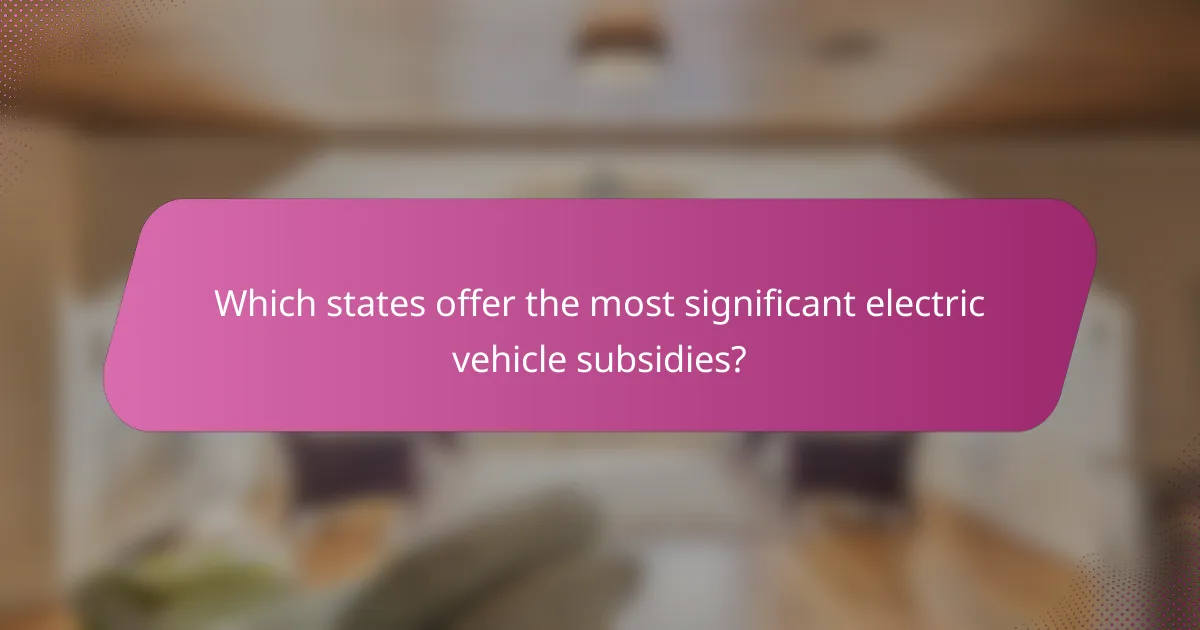
Which states offer the most significant electric vehicle subsidies?
California, New York, and Texas are among the states providing the most substantial electric vehicle (EV) subsidies. These incentives can significantly reduce the cost of purchasing an EV, making them more accessible to consumers.
California
California leads the nation in electric vehicle subsidies, offering a variety of incentives to encourage EV adoption. The state provides rebates of up to $7,000 for eligible electric vehicles, depending on the model and buyer income level.
In addition to rebates, California has various programs like the Clean Vehicle Rebate Project (CVRP) and the California Clean Fuel Reward, which further reduce costs. Buyers should also consider local incentives, which can vary by city and may include additional rebates or tax credits.
New York
New York offers significant electric vehicle subsidies through its Drive Clean Rebate program, providing rebates of up to $2,000 for eligible EVs. The amount of the rebate depends on the vehicle’s battery capacity and the buyer’s income level.
Additionally, New York City has its own incentives, including a tax credit for EV charging stations. Consumers should check both state and local programs to maximize their savings when purchasing an electric vehicle.
Texas
Texas provides a more modest subsidy for electric vehicles compared to California and New York, with rebates of up to $2,500 available through the Texas Electric Vehicle Grant Program. This program is designed to promote the use of electric vehicles across the state.
While the state incentives may be lower, Texas also offers benefits such as no state sales tax on the purchase of electric vehicles. Buyers should explore local utility incentives, as some providers offer rebates for EV charging infrastructure, which can further enhance savings.

How do subsidies influence consumer purchasing decisions?
Subsidies significantly impact consumer purchasing decisions by lowering the effective cost of electric vehicles (EVs), making them more attractive to buyers. These financial incentives can lead to increased sales and a shift in consumer perception towards electric mobility.
Lower upfront costs
Subsidies reduce the initial purchase price of electric vehicles, making them more affordable for a broader range of consumers. For example, in the United States, federal tax credits can range from $2,500 to $7,500, depending on the vehicle’s battery capacity. This reduction in upfront costs can be a decisive factor for many buyers who might otherwise opt for traditional gasoline vehicles.
Additionally, some states and local governments offer additional rebates or incentives, further decreasing the total cost. Consumers should research available subsidies in their region to maximize savings when purchasing an EV.
Increased awareness of electric vehicles
Government subsidies often come with marketing initiatives that raise awareness about electric vehicles and their benefits. As consumers learn more about the advantages of EVs, such as lower operating costs and environmental benefits, their interest in purchasing these vehicles increases.
Moreover, subsidies can lead to greater visibility for electric vehicles in dealerships and on the road, reinforcing their presence in the market. This heightened awareness can shift consumer attitudes, making EVs a more mainstream choice over time.
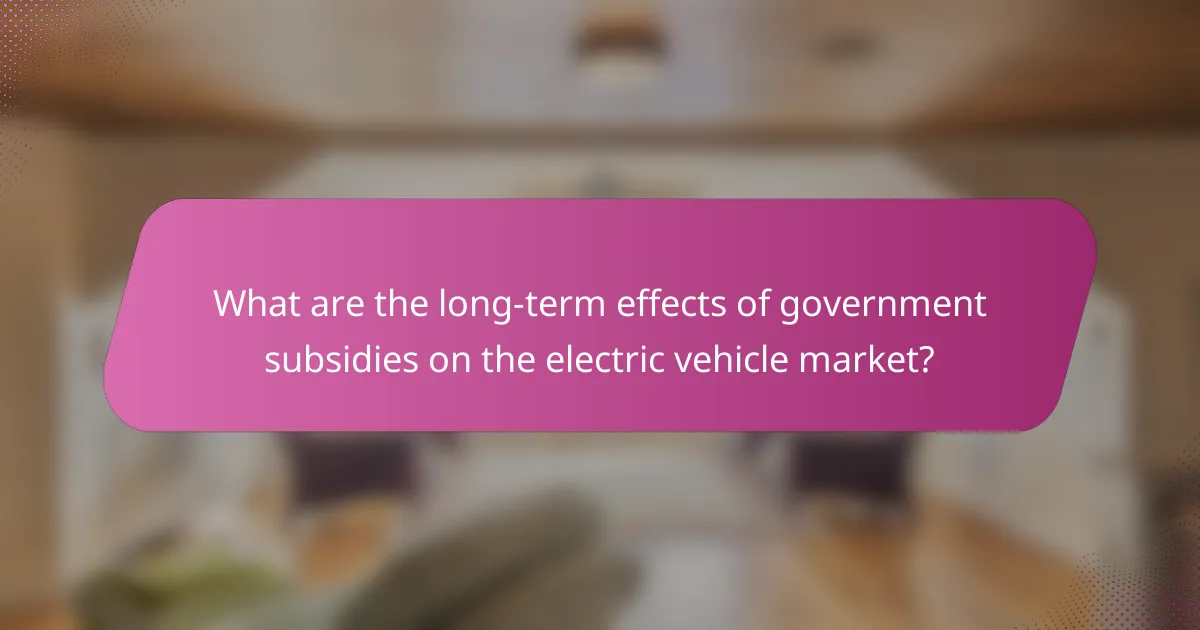
What are the long-term effects of government subsidies on the electric vehicle market?
Government subsidies significantly impact the electric vehicle (EV) market by making EVs more affordable and encouraging consumer adoption. Over time, these financial incentives can lead to increased market stability and growth, fostering a more sustainable automotive industry.
Market sustainability
Government subsidies contribute to market sustainability by lowering the initial purchase price of electric vehicles, making them more accessible to a broader audience. As more consumers opt for EVs, manufacturers are incentivized to invest in production, leading to economies of scale that can further reduce costs.
Additionally, sustained subsidies can encourage innovation in EV technology and infrastructure, ensuring that the market remains competitive. However, reliance on government support may pose risks if subsidies are reduced or eliminated, potentially destabilizing the market.
Investment in charging infrastructure
Subsidies often extend beyond vehicle purchases to include investments in charging infrastructure, which is crucial for the widespread adoption of electric vehicles. Governments may allocate funds to build public charging stations, making it easier for consumers to transition to EVs without range anxiety.
Effective charging infrastructure investment can significantly enhance the practicality of owning an electric vehicle. For instance, a well-distributed network of fast chargers can reduce charging times to under an hour, making EVs a more convenient option for daily use. Local governments should prioritize these investments to support long-term EV market growth.

What criteria should consumers consider when evaluating electric vehicle subsidies?
Consumers should consider eligibility requirements, the types of vehicles covered, and the potential financial benefits when evaluating electric vehicle subsidies. Understanding these factors can help buyers make informed decisions and maximize their savings.
Eligibility requirements
Eligibility for electric vehicle subsidies often depends on factors such as income level, residency, and the specific vehicle model. Many programs require buyers to meet certain income thresholds, ensuring that the benefits target those who need them most.
Additionally, some subsidies may only be available to residents of specific states or regions. It’s essential to check local regulations to determine if you qualify for any available incentives.
Types of vehicles covered
Subsidies typically apply to a range of electric vehicles, including fully electric cars, plug-in hybrids, and sometimes even electric motorcycles. However, not all models qualify, so it’s crucial to verify which vehicles are eligible for the incentives you are considering.
For example, in the United States, certain federal tax credits are available for specific makes and models, while some states offer additional incentives for electric vehicles that meet local environmental standards. Always check the latest lists of eligible vehicles to ensure you are making a qualified purchase.

What are the challenges associated with government subsidies for electric vehicles?
Government subsidies for electric vehicles (EVs) face several challenges that can impact their effectiveness and sustainability. These challenges include budget constraints, market distortion, and the potential for inequitable access among consumers.
Budget Constraints
Government budgets often have limited resources, which can restrict the availability of funds for EV subsidies. As more countries aim to promote electric mobility, the competition for financial support may increase, leading to potential cuts or reductions in subsidy amounts.
For instance, in the United States, federal and state subsidies can vary significantly, with some states offering generous incentives while others provide minimal support. This inconsistency can create confusion and limit the overall impact of subsidies on EV adoption.
Market Distortion
Subsidies can lead to market distortions by artificially inflating demand for electric vehicles. This can result in manufacturers focusing on producing models that qualify for subsidies rather than those that meet consumer needs. Over time, this may hinder innovation and the development of a diverse EV market.
Additionally, if subsidies are not phased out as the market matures, they can create dependency, making it difficult for manufacturers to adjust to a subsidy-free environment. This could lead to sudden price increases once subsidies are removed.
Inequitable Access
Government subsidies may not reach all consumers equally, often favoring higher-income individuals who can afford to purchase EVs upfront. This can exacerbate social inequalities, as lower-income households may miss out on the benefits of electric mobility.
To address this issue, some governments are exploring alternative approaches, such as providing incentives for public transportation or investing in charging infrastructure in underserved areas. These strategies aim to ensure that the transition to electric vehicles is inclusive and equitable for all segments of the population.

